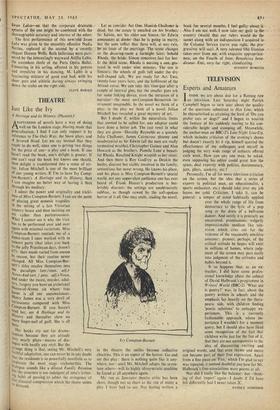\VH1 1 invn, WHITE to play and mate in two
moves ; solution next week. Solution to No. 231 (Rinck) I3—B 4 I, QxB (otherwise 2 P—Kt 8=Q ch will win) ; 2 R—R r!, B x R; 3 P—Q 5 and now (a)3 . . B xP ; 2 P—Kt 8=Q ch, B x Q ; 3 P—R mate or (b) 3 ... Q x R • 2 P—R Q ch, Q x Q ; 3 P—Kt 8 =IQ mate. A problem theme in study form ; it is necessary to draw the Q and B across the critical square Q 5 before playing P—Q5—the idea will become clear if you try playing P—Q 5 at an earlier stage.
The American periodical Chess Life ru▪ ns an agree- able feature called 'Chess Encores'—reprints of old games that are worth reviving. I give an example this week ; readers might like to try the variation them- selves—most things wilt work once.
White, MAX LANGE. Black, VON SCHIERSTEDT, Opening, SCOTCH GAMBIT.
(Played in 1857)
P—K 4 P—K 4
2 Kt—K B Kt—Q B 3 3 P--Qo P x P 4 B-1,2 Kt 3 • . • Nowadays B—Q B 4 is normally
played. Here, however, is a modern example for comparison.
4 11 Kt 5, B—Kt 5 ch; 5 P—B 3, P x P; 6 0-0, K Kt—K 2;
7 P x , B—B 4' 8 Kt—Kt 5, P—Q 3; 9 Q—R 5, Kt—Kt 3; toP—K 5, Kt xP; it R—K 1,Q—K a; ta 13—K B 4,11—K Kt 5;
13 9—u 4, B—Q 2; 14 Q it 2, 0 0 0, and Black has
survived the attack and is two pawns up (Kholmov—Shiyanovsky, USSR Championship. 1961). But maybe White's play could be improved.
B—B 4 Less good than 11—Kt 5 ch.
5 0-0 K 10—K
6 Q Kt—Q 2 P—Q 4 6.. . P-9 3; 7 Kt—Kt 3, l3--QM Q 2 is more solid. but the text should be playable. 7 PxP Q x P B—B 4 Q—Q r? This move combined with
o . . . P—Q 4 is unhappy mixture of aggression and timidity. Better 8 . . . Q—R followed by B—Kt 5—or if 9 P—K R 3, then 9 . 0-0.
9 Kt—Kt g Kt—K 4 What else? 9 .. 0-0?; 10 Q—R 5 Or 9 . . Kt---Q 4; 10 Kt x P, K x Kt; it Q—B 3 ch. ro Kt x P1 Kt x Kt rr BxKt ch KxB 12 Q—R 5 ch P—Kt 3 1 think 12 . . . Kt—Kt 3; 13 Q x B, P—Kt 3 gives better defensive chances.
14 K Kt 5. —Kt is Q—B .4 ch, Kt—B 4, and i FQ B Kt—B3 Better 13 I3 . . . P—Kt 3, g Kt 4? then t6 . . . 31 is adequate. The knight is useless on Q.13 3.
14 Kt—B 3 R—K
rs B—R 61 B—B 4 Better 15 B—K 3, but after 16 Q R—K t with the threat Kt—Kt 5 ch Black is poorly placed. r6 §R—K 9—Q2 17 —B 4 ch u—K 3 ;8 t--Kt 5 ch K=B 3 ro Q—K a B—Kt 52 Natural but weak. 19 . . . 13—Q 4 is best, !hough after 20 Q--Q 2 White stands very well. 20 P—B 3! R x Q2 lie should play B—B 4. 2l P x B ch K—K 4 22 RxR ch • K-24 23 10—K4*! K— 5 Kt—B 6 ch was threatened. 24 P-9 it 41 9 xP 25 P—Rt 3 ch 1C—K; s6 B-42_2 ch K—R e 27 Kt—B 31 . • • Threat 213 R—R 1 ch, K—Kt 7; • R—R 2 mate. Px Kt 01-27 ... K—Kt 5; 28 R—K 51, P x Kt; 29 R—Kt 5 ch, K—R 6; ,3o B x P, Q—Q 5. chi; 3t B x Q, Kt x B; 32 R x P and White wins, but much less quickly. as Dxp Kt—Kt 5


































 Previous page
Previous page